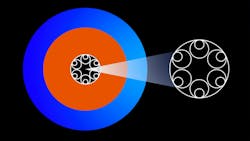Comcast deploys hollowcore fiber link in search of lower latency
Comcast has revealed that it has deployed hollowcore fiber, alongside conventional fiber, on a 40-km link in Philadelphia. The link is being used to evaluate the low-latency and other potentially beneficial characteristics of the advanced fiber type.
As its name implies, hollowcore fiber does not have the solid glass core typical of conventional single-mode and multimode fibers. Light instead is transmitted through air in the hollow core. The removal of the solid core also removes some of that material’s transmission-retardant properties. For example, light can travel nearly 50% more quickly in air than in solid glass, resulting in a latency reduction of up to 33%, according to Comcast. Hollowcore fibers also should be less susceptible to nonlinear effects, potentially helping reach and perhaps putting less strain on coherent engines or even opening the door for less robust and therefore cheaper engines. Comcast has already demonstrated the fiber’s ability to support coherent transmission, data rates from 10G to 400G, as well as single-fiber bidirectional transmission.
However, hollowcore fibers traditionally have suffered from significantly greater attenuation than conventional fibers, limiting the reaches they can support and therefore the fibers’ practicality. Elad Nafshi, executive vice president and chief network officer at Comcast Cable, acknowledged that attenuation remains a concern; the 40-km deployment is believed to be the longest achieved by an ISP and is significantly greater than the 7 km that was the previous record commercial deployment for Comcast’s hollowcore fiber partner for the link, Lumenisity Ltd. of the UK.
However, Lumenisity’s approach to hollowcore, nested anti-resonant nodeless fiber (NANF), has been praised by sources at BT Labs (which has also evaluated the fiber) as offering significant promise towards attenuation reduction. In fact, Lumenisity has announced a second generation of its fiber, called DNANF (with “D” for “double”), that the company asserts will equal if not surpass the attenuation performance of standard single-mode fiber. Lumenisity expects to offer such fiber within its CoreSmart cables in the second half of this year.
Meanwhile, Comcast’s ability to leverage hollowcore on its current link is enough to get Nafshi’s attention. “Forty kilometers, that’s starting to be real,” he said. While he declined to speculate when and where Comcast might deploy hollowcore fiber, Nafshi noted that such fibers could benefit customers seeking the lowest latency possible (hollowcore fibers have already been deployed by other operators to support high-frequency trading, for example) or where latency concerns previously have limited the distance between network elements.
About the Author

Stephen Hardy
Editorial Director & Associate Publisher
Stephen Hardy is editorial director and associate publisher of Lightwave and Broadband Technology Report, part of the Lighting & Technology Group at Endeavor Business Media. Stephen is responsible for establishing and executing editorial strategy across the both brands’ websites, email newsletters, events, and other information products. He has covered the fiber-optics space for more than 20 years, and communications and technology for more than 35 years. During his tenure, Lightwave has received awards from Folio: and the American Society of Business Press Editors (ASBPE) for editorial excellence. Prior to joining Lightwave in 1997, Stephen worked for Telecommunications magazine and the Journal of Electronic Defense.
Stephen has moderated panels at numerous events, including the Optica Executive Forum, ECOC, and SCTE Cable-Tec Expo. He also is program director for the Lightwave Innovation Reviews and the Diamond Technology Reviews.
He has written numerous articles in all aspects of optical communications and fiber-optic networks, including fiber to the home (FTTH), PON, optical components, DWDM, fiber cables, packet optical transport, optical transceivers, lasers, fiber optic testing, DOCSIS technology, and more.
